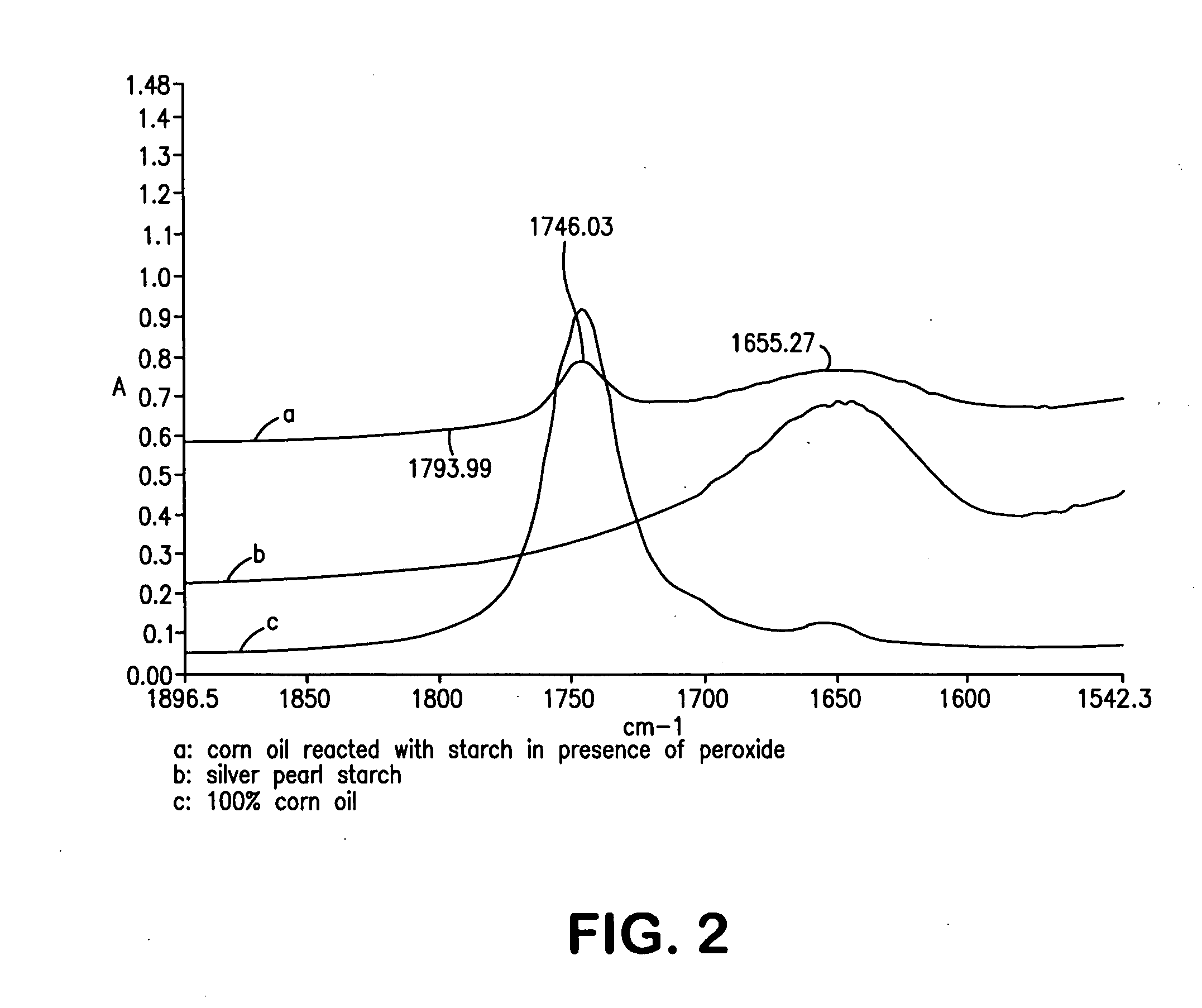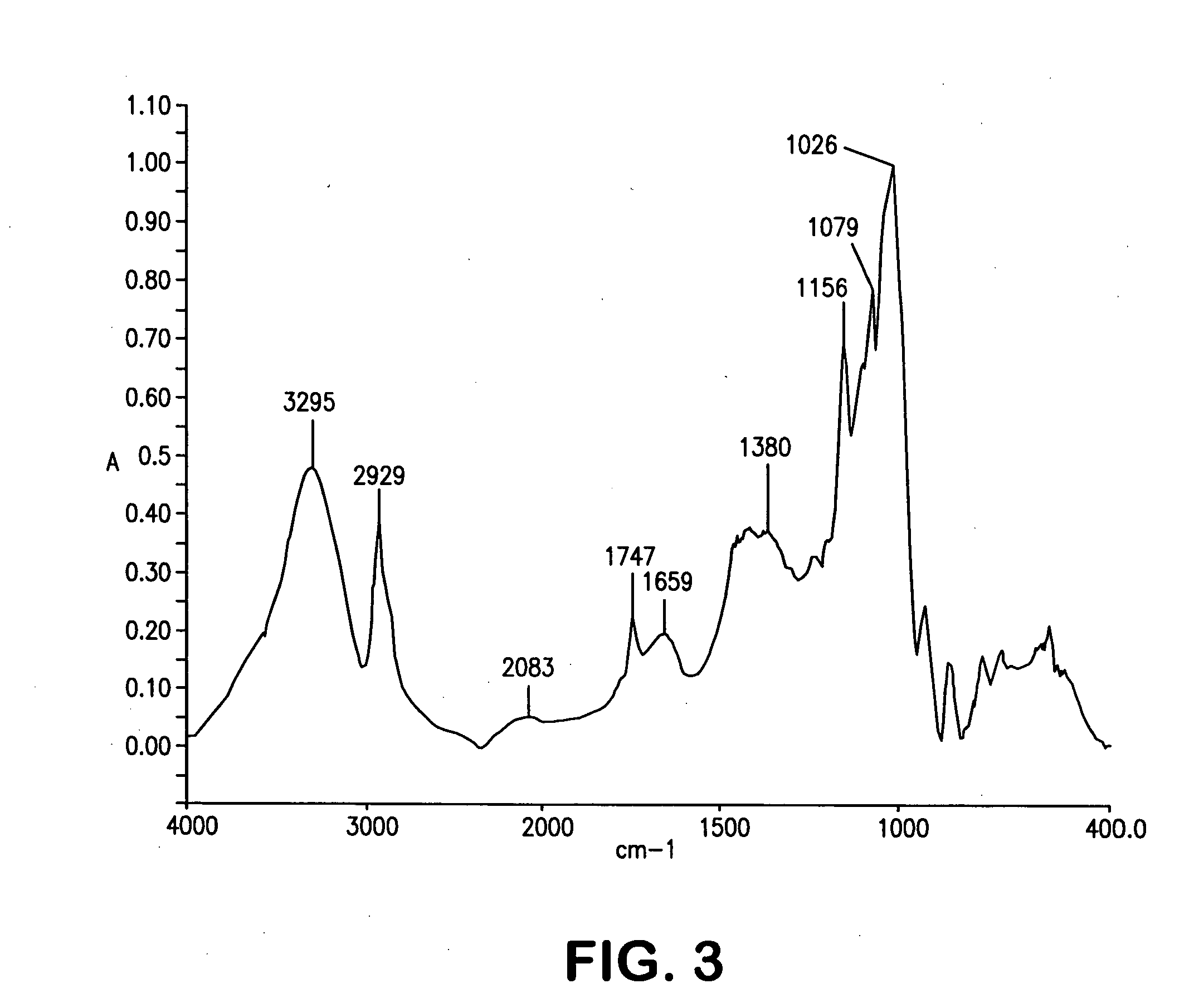Starch-vegetable oil graft copolymers and their biofiber composites, and a process for their manufacture
a technology of starchvegetable oil graft and biofiber, which is applied in the field of thermoplastic starchvegetable oil graft copolymers and their biofiber composites, can solve the problems of poor recycling effect of plastic and organic waste, poor choice of landfills, and incompatibility of plastics with waste management infrastructures, etc., and achieves good mechanical properties and easy processing
- Summary
- Abstract
- Description
- Claims
- Application Information
AI Technical Summary
Benefits of technology
Problems solved by technology
Method used
Image
Examples
example 1
[0060] A starch modification reaction was carried out as follows:
[0061] 740 gm of granular corn-starch (Corn Products, Inc.) was mixed with 71.5 gm of corn oil (Corn Products, Inc.). Further, 185.3 gm glycerol was mixed with 3.2 gm of 2,5-Bis (tert-butylperoxy)-2,5-dimethylhexane (LUPEROX 101 (Aldrich). The two mixtures were mixed in a blender for 15 minutes and extruded using a CENTURY twin-screw co-rotating extruder with a screw diameter of 30 mm and a L / D of 40. The temperature profile and the extrusion processing conditions are shown in Table 1. Screw configuration consisting of both conveying and kneading elements was used and is shown in FIG. 1. D.S.=(162*W) / (100*M−(M−1)*W), where 162 represents the molecular weight of one anhydroglucose unit, W is the weight % of the substituent and M the molecular weight of the substituent. In our case, W=7.18 and M=870 g / mol. This translates to a theoretical D.S. value of 0.014 (i.e. one mol of corn oil per 100 glucose units). The starch-c...
example 2
[0062] A starch modification reaction following the procedure as explained in Example 1 was carried out as follows:
[0063] 740 gm of granular corn-starch (Corn Products, Inc.) was mixed with 71.5 gm of maleated corn oil (1 mole of maleated corn oil contains one mole of maleic anhydride). Further, 185.3 gm glycerol was mixed with 3.2 gm of 2,5-Bis(tert-butylperoxy)-2,5-dimethylhexane (LUPEROX 101 (Aldrich). The two mixtures were mixed in a blender for 15 minutes and extruded using a CENTURY twin-screw co-rotating extruder with a screw diameter of 30 mm and a L / D of 40. The temperature profile and the extrusion processing conditions are shown in Table 1. Screw configuration consisting of both conveying and kneading elements was used and is shown in FIG. 1. D.S.=(162*W) / (100*M−(M−1)*W), where 162 represents the molecular weight of one anhydroglucose unit, W is the weight % of the substituent and M the molecular weight of the substituent. In this case, W=7.18 and M=968 (870 of CO+98 of ...
example 3
[0064] A starch modification reaction following the procedure as explained in Example 1 was carried out as follows:
[0065] 740 gm of granular corn-starch (Corn Products, Inc.) was mixed with 74.7 gm of maleated corn oil (1 mole of maleated corn oil contains one mole of maleic anhydride). Further, 185.3 gm glycerol was added and the mixture was kneaded in a kitchen blender for 15 minutes and extruded using a CENTURY twin-screw co-rotating extruder with a screw diameter of 30 mm and a L / D of 40. The temperature profile and the extrusion processing conditions are shown in Table 1. Screw configuration consisting of both conveying and kneading elements was used and is shown in FIG. 1. D.S.−(162*W) / (100*M−(M−1)*W), where 162 represents the molecular weight of one anhydroglucose unit, W is the weight % of the substituent and M the molecular weight of the substituent. In this case, W=7.18 and M=968 (870 of CO+98 of MA). This translates to a theoretical D.S. value of 0.012 (i.e. one mol of c...
PUM
| Property | Measurement | Unit |
|---|---|---|
| Fraction | aaaaa | aaaaa |
| Fraction | aaaaa | aaaaa |
| Fraction | aaaaa | aaaaa |
Abstract
Description
Claims
Application Information
 Login to View More
Login to View More - R&D
- Intellectual Property
- Life Sciences
- Materials
- Tech Scout
- Unparalleled Data Quality
- Higher Quality Content
- 60% Fewer Hallucinations
Browse by: Latest US Patents, China's latest patents, Technical Efficacy Thesaurus, Application Domain, Technology Topic, Popular Technical Reports.
© 2025 PatSnap. All rights reserved.Legal|Privacy policy|Modern Slavery Act Transparency Statement|Sitemap|About US| Contact US: help@patsnap.com



